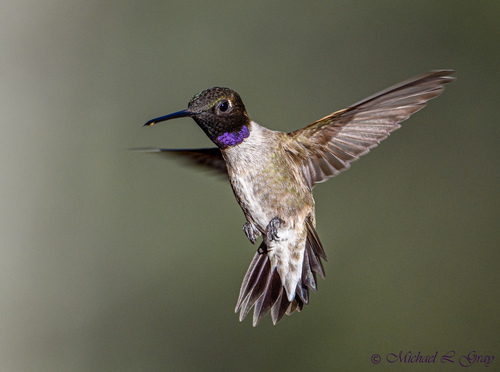
Black-chinned Hummingbird
The Black-chinned Hummingbird (*Archilochus alexandri*) is a small, vibrant hummingbird species native to North America. Known for its remarkable agility and iridescent plumage, it plays a crucial role as a pollinator for various flowering plants. This species exhibits fascinating migratory behaviors, traveling long distances between breeding and wintering grounds. Culturally, hummingbirds often symbolize joy, energy, and adaptability, appearing in various folklore and artistic representations.
7.6-9 cm
Length
10-12 cm
Wingspan
Least Concern
Conservation Status
Distribution
Breeds across western North America, from southern British Columbia and Alberta in Canada, through the western United States, down to northern Mexico. Migrates to central and southern Mexico for wintering.
Lifespan
Average lifespan in the wild is 3-5 years, but some individuals have been recorded living up to 9 years.
Black-chinned Hummingbird's Habitat
Habitat Types
Riparian woodlands, Mountain meadows, Chaparral, Suburban gardens, Desert canyons
Climate Zones
Temperate, Arid, Semi-arid
Adaptations
Highly adaptable to various elevations and vegetation types, provided there are sufficient nectar sources and small insects. They can enter torpor, a state of reduced metabolic activity, to conserve energy during cold nights.
Variations
No recognized subspecies, but slight variations in size and coloration may occur across its extensive range.
Appearance
Breeding Plumage
Males have a black chin with a distinctive iridescent purple band below it during breeding season. Females and non-breeding males have a dull greenish back and whitish underparts.
Seasonal Feather Changes
Male's iridescent throat patch is most vibrant during the breeding season.
Sex Based Plumage Differences
Significant. Males possess the black chin and purple band, while females lack these markings.
Notable Features
Long, slender, needle-like bill, Iridescent green back (in both sexes), Rapid wingbeats creating a humming sound
Diet and Feeding
Primary Foods
Nectar, Small insects, Spiders, Tree sap
Foraging Behavior
Hovers while feeding from flowers, using its long bill and tongue to access nectar. Also gleans insects from foliage and catches them in mid-air.
Specializations
Brush-tipped tongue adapted for efficient nectar extraction. High metabolic rate requires frequent feeding.
Seasonal Diet Variations
Relies heavily on nectar during breeding season. Insect consumption increases when feeding young and during migration to fuel energy reserves.
Behavior
Social Structure
Generally solitary except during breeding season. Males are highly territorial during breeding, defending feeding territories.
Communication
High-pitched chirps and chatters, Wing hums during flight displays, Aggressive buzzing sounds during territorial disputes
Migration
Migratory, traveling long distances between breeding and wintering grounds. Travels alone, often following specific flyways along mountain ranges and coastlines.
Territorial or Group Behaviors
Males aggressively defend feeding territories, particularly those with abundant nectar sources, from other males and even other hummingbird species.
Conservation
Threats
Habitat loss due to urbanization and agriculture, Pesticide use affecting insect prey, Climate change impacting flowering times and nectar availability, Collisions with windows and other structures
Protection Programs
Habitat restoration projects, Promotion of native plant gardens, Public awareness campaigns about hummingbird conservation
Local National Laws
Protected under the Migratory Bird Treaty Act in the United States, Canada, and Mexico.
Population Trend
Stable
Population Estimates
Global population estimated to be around 8.2 million.
Interesting Facts
Black-chinned Hummingbirds can fly forward, backward, and even upside down.
Their unique wing structure and musculature allow for exceptional maneuverability.
They have one of the highest metabolic rates of any vertebrate.
This requires them to consume large amounts of nectar and insects relative to their size.
Their heart rate can reach over 1,200 beats per minute during flight.
This rapid heart rate is necessary to support their high-energy flight.
They can remember the location of individual flowers and return to them.
This spatial memory is crucial for efficient foraging.
Faqs about Black-chinned Hummingbird
How can I attract Black-chinned Hummingbirds to my garden?
Plant native flowering plants, especially those with red or orange tubular flowers. Provide a hummingbird feeder with a sugar-water solution (1 part sugar to 4 parts water), and ensure a clean water source.
What should I do if I find an injured hummingbird?
Contact a local wildlife rehabilitator or veterinarian specializing in avian care. Do not attempt to care for it yourself without professional guidance. Consult a professional for medical or expert advice.
Do Black-chinned Hummingbirds return to the same place every year?
They often show site fidelity, returning to the same breeding and wintering areas, and even the same feeders, year after year.
How fast do they fly?
Black-chinned Hummingbirds can reach speeds of up to 385 body lengths per second during their dives. This translates to around 27 mph (43 km/h) relative to their body size, though they may go much faster during courtship dives.
Copyright @ Nature Style Limited. All Rights Reserved.
 English
English